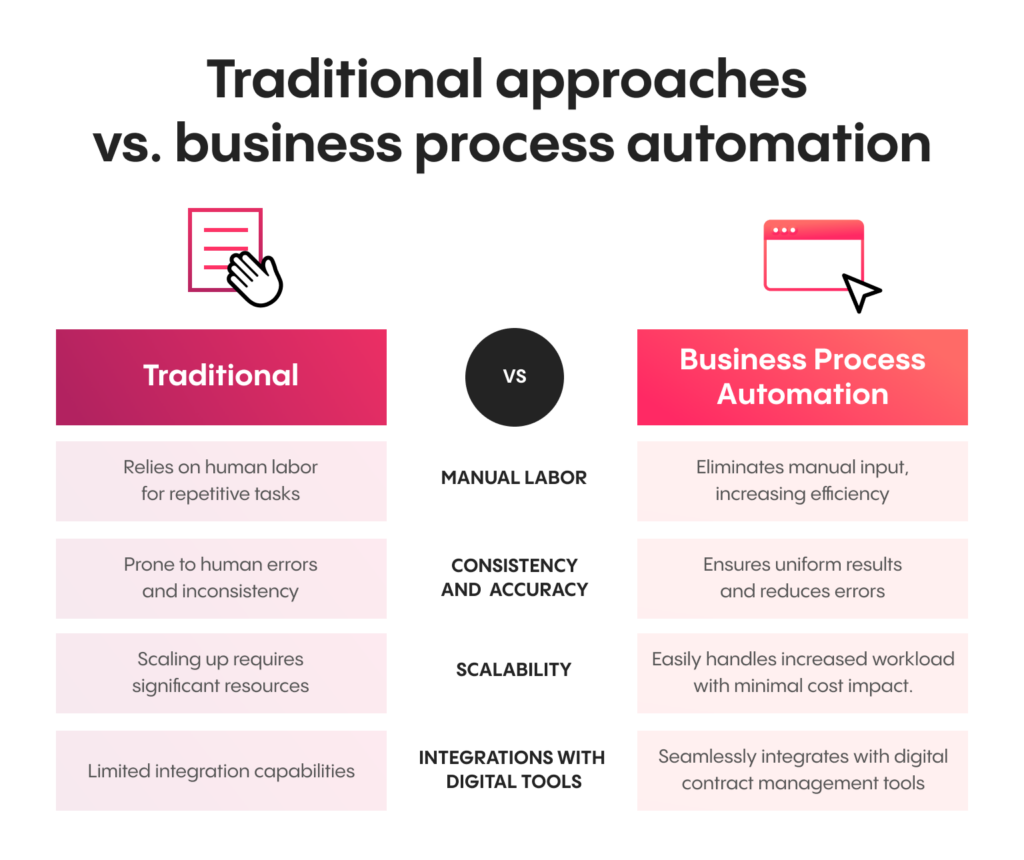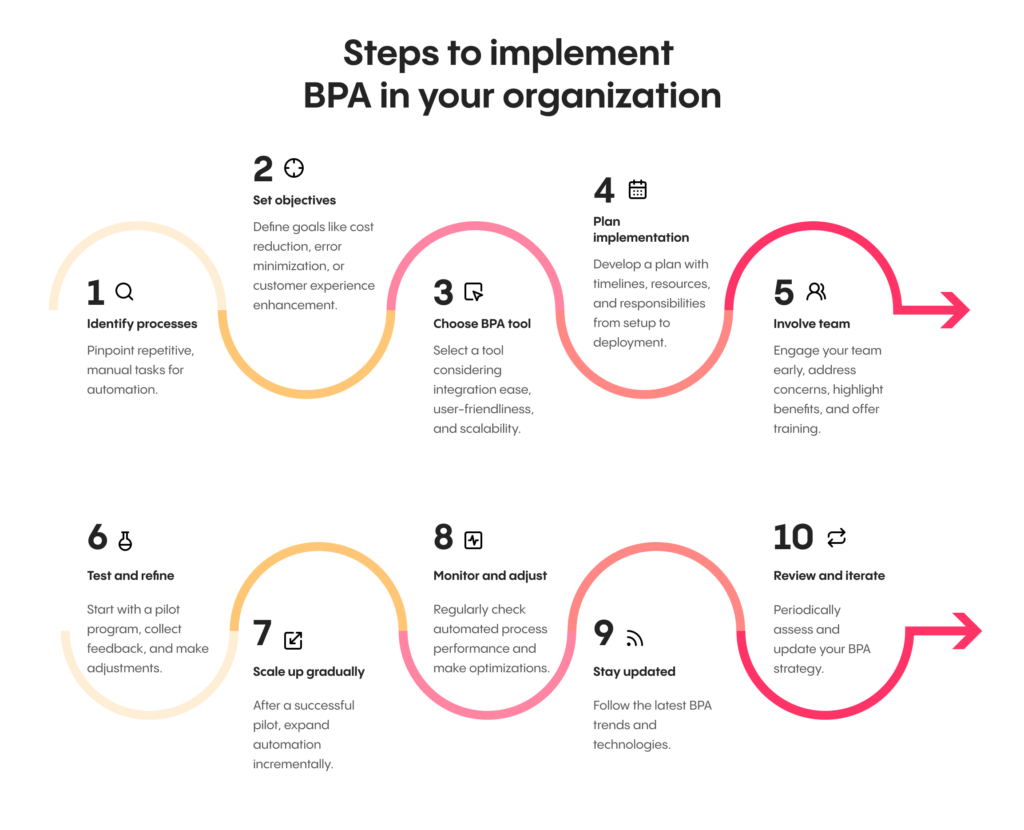Business Process Automation: The Ultimate Guide
Table of contents
- What is business process automation?
- Core concepts and components of BPA
- Benefits of implementing BPA in business operations
- Frequently automated business processes
- Challenges in BPA Implementation
- Strategic considerations for successful BPA deployment
- Choosing the right BPA tools and software
- Criteria for selecting BPA tools for your business
- Steps for implementing BPA in your organization
- Future trends and developments in BPA
- Conclusion: Maximizing the impact of BPA
Today, business process automation (BPA) is revolutionizing the way companies operate. BPA touches every aspect of a business, from data entry to customer interactions, significantly increasing efficiency and accuracy.
By the end of this guide, you’ll be equipped to leverage BPA for improved productivity and strategic growth in your organization. Let’s jump right in with a straightforward definition.
What is business process automation?
Business process automation (BPA) is a technology-driven strategy that replaces manual, repetitive tasks in your business with automated solutions. At its core, BPA is about using technology like contract management software to perform routine business processes with minimal human intervention. This approach streamlines workflows, making them more efficient and less prone to human error.

Differences between traditional approaches and business process automation
- Automation vs. manual processes: BPA eliminates the need for manual input in repetitive tasks, contrasting with traditional methods that heavily rely on human effort.
- Consistency and accuracy: Automated processes deliver consistency and reduce errors compared to manual operations.
- Scalability: Unlike manual processes, BPA can easily scale up to handle increased workload without significant additional costs.
- Integration capabilities: BPA systems can integrate with digital tools for contract management, which manual or semi-automated systems can’t do.
In short, a BPA approach can enhance your entire operational framework — making it more resilient, efficient, and ready for future growth.
Core concepts and components of BPA
Business process automation revolves around several key concepts and components that work together to streamline your business operations.
Key BPA concepts
- Workflow automation: Streamlining standard business processes to reduce manual handling and improve efficiency.
- Process optimization: Continuously improving and refining processes for maximum efficiency and effectiveness.
- Task automation: Using software to automatically handle repetitive tasks, reducing time consumption and human error.
- Data-driven decision making: Leveraging automated data collection and contract management reporting to inform business logic.
Components of BPA systems
- Software applications: The core of BPA, these applications automate processes and manage workflows.
- Integration tools: These allow BPA systems to connect with other business software, ensuring seamless data flow and functionality.
- User interface: A user-friendly platform where employees interact with the BPA system to monitor and manage automated processes.
- Analytics and reporting tools: Provide insights into process performance, highlighting areas for improvement.
- Security features: Essential for protecting sensitive data and ensuring compliance with regulations.
Together, these concepts and components form the foundation of a successful automation strategy, helping you streamline your operations and elevate your business performance.
Benefits of implementing BPA in business operations
Integrating business process automation into your operations can yield significant benefits, transforming the way your business functions.
Advantages of implementing BPA
- Increased efficiency and productivity: Automation speeds up repetitive manual tasks, freeing your team to focus on more strategic activities.
- Cost reduction and error minimization: BPA reduces operational costs by cutting down on manual labor and minimizing errors caused by human intervention.
- Enhanced compliance and reporting: Automated processes ensure adherence to regulatory standards and simplify reporting.
- Improved customer satisfaction: Faster and more accurate processes lead to better customer experiences.
- Data-driven insights: Automated data collection and analysis offer valuable insights for informed decision-making.
- Scalability: BPA solutions can grow with your business, accommodating increased workloads without the need for additional staffing.
- Employee satisfaction: Automating mundane tasks allows your employees to engage in more meaningful and satisfying work.
- Environmental benefits: Reducing paper-based processes contributes to your company’s sustainability efforts.
By adopting BPA, you position your business for greater operational success, leveraging technology to optimize performance and drive growth.
Frequently automated business processes
Incorporating business process automation into operations can significantly enhance efficiency. Here are some common processes that businesses often automate, along with examples for each.
Customer service
AI chatbots can handle routine customer inquiries automatically, offering quick responses and improving overall satisfaction. This reduces wait times and frees up your team for more complex queries.
Employee onboarding
Streamlining the onboarding process with automated workflows allows new hires to submit documents and access training schedules effortlessly. It ensures a smooth start for new employees and reduces contract administration overhead. When expanding into new markets, using an employer of record in Latin America or, e.g., in Eastern Europe can reduce onboarding delays caused by unfamiliar administrative procedures.
Invoice processing
Automation software can generate, send, and track invoices, significantly reducing the time spent on manual data entry and follow-ups. This leads to faster billing cycles and improved cash flow management.
Inventory management
Automated systems track inventory levels, reorder products, and manage supply chain logistics efficiently. This helps maintain optimal stock levels and reduces the risk of overstocking or stockouts.
Email marketing
Tools that segment audiences, personalize messages, and schedule campaigns automate many aspects of email marketing. This results in more effective campaigns and better engagement with less effort.
Appointment scheduling
Online scheduling tools allow customers to book appointments at their convenience, reducing the need for manual scheduling. It improves customer experience and reduces the administrative burden.
Contract management
Automating the creation, approval, and renewal of contracts streamlines legal processes. Contract automation minimizes paperwork and ensures timely handling of contractual obligations.
Social media management
Scheduling social media posts and analyzing engagement data through automation tools maintains a consistent online presence. It allows more strategic use of social media with less time spent on daily postings.
By automating these processes, you can streamline operations, reduce the workload on your team, and focus on growth and strategy.
Challenges in BPA Implementation
Implementing business process automation can bring significant benefits, but it’s important to navigate some common challenges.
Integration with existing systems
Integrating BPA tools with existing systems can be complex. Plan the integration carefully, considering compatibility and potential disruptions to minimize impact on current operations.
Employee resistance
Changes in workflows can sometimes meet with resistance from employees. Address this by involving your team in the process, communicating the benefits, and providing adequate training and support.
Initial costs
The upfront investment in BPA software and infrastructure can be significant. Balance these initial costs by creating a clear ROI roadmap, showing long-term savings and efficiency gains.
Complexity of processes
Automating highly complex or unique business processes may require customized solutions. Work closely with software developers or vendors to create tailored automation solutions that fit these unique needs.
Data privacy and security
Handling sensitive data in automation processes raises concerns about privacy and security. Prioritize robust security measures and compliance with data protection regulations to safeguard information.
Strategic considerations for successful BPA deployment
You’ll also want to keep the following strategic considerations in mind as you plan a rollout of BPA across your department, or your entire organization.
Assess your existing needs
Carefully evaluate which business processes will benefit most from automation. This helps in prioritizing and achieving more impactful results.
Get employees involved
Getting your team on board is crucial for smooth adoption. Involve employees early in the process, seek their input, and help them understand the benefits of BPA.
Choose your toolkit carefully
Selecting appropriate BPA software is key. Look for tools that not only meet your current needs but also offer scalability and integration capabilities.
Roll out in phases
Implementing automation in phases allows for adjustments and fine-tuning. Start with less complex processes and gradually scale up to more complex ones.
Track, iterate and improve
Regularly review and assess the performance of automated processes. Use feedback and performance data to continuously improve and adapt your BPA strategy.
Choosing the right BPA tools and software
Finding the ideal BPA tools and software is key to maximizing the benefits of business process automation. Here are some popular options, along with their pros and cons:
Automation Anywhere
This platform offers a user-friendly interface ideal for automating complex business processes. Its strength lies in its advanced features, but it may require a steeper learning curve for beginners.
SS&C Blue Prism
Known for its robust, enterprise-grade capabilities, Blue Prism is suitable for large-scale operations needing extensive automation. While powerful, it can be more costly and less intuitive for smaller businesses or those new to BPA.
UiPath
UiPath provides a versatile solution that caters to businesses of all sizes. It’s known for its ease of use, though some advanced features may require more technical expertise.
Zapier
Great for integrating various web applications, Zapier automates tasks without needing technical skills. It’s user-friendly but may be limited in handling more complex automation needs.
Microsoft Power Automate
This tool, formerly Microsoft Flow, excels in automating workflows and integrating various Microsoft applications. While it integrates seamlessly with the Microsoft ecosystem, its reliance on this ecosystem can be a limitation for some users.
Concord
Concord specializes in contract lifecycle management with strong automation features. It’s ideal for streamlining contract processes, though its focus on documents might not cover all general business automation needs.
Criteria for selecting BPA tools for your business
When choosing BPA tools for your organization, you’ll want to keep these criteria in mind.
Compatibility with existing systems
Tools should integrate seamlessly with your current software to avoid disruption. Incompatibility can lead to additional costs and complexities.
Ease of use
User-friendly interfaces are crucial for quick adoption and efficiency. Tools that are difficult to navigate can slow down your transition to automation.
Scalability
Your chosen tool should be able to grow with your business, handling increased workloads without performance issues. Lack of scalability can result in needing to switch tools as your business expands, which can be costly.
Customization options
Flexibility to tailor processes to your business needs ensures that the tool serves your specific requirements. Limited customization can hinder the tool’s effectiveness.
Cost-effectiveness
Weigh both initial setup costs and ongoing expenses against the features offered. High costs without a clear return on investment can strain your budget.
Support and training
Adequate vendor support and training resources are vital for effective implementation and use. Poor support can lead to prolonged implementation times and reduced user adoption.
By considering these aspects, you can select a BPA tool that aligns well with your business’s current and future needs, creating a smooth transition and effective automation.
Steps for implementing BPA in your organization
Implementing business process automation in your organization involves a series of tactical stages. Here’s a step-by-step guide to help you navigate this transition.

Identify processes to automate
Start by pinpointing repetitive, manual tasks within your business. These tasks are ideal candidates for automation, as they often consume significant time and are prone to errors.
Set clear objectives
Clearly define your goals with automation, such as reducing operational costs, minimizing errors, or enhancing customer experience. This clarity will guide your choice of processes and tools for automation.
Choose the right BPA tool
Research and select a BPA tool that suits your specific business requirements. Consider factors like ease of integration, user-friendliness, and long-term scalability.
Plan your implementation
Create a detailed implementation plan that includes timelines, resource allocation, and clear responsibilities. This plan should outline each step of the process, from initial setup to full-scale deployment.
Involve your team
Engage your team early in the process, addressing any concerns and highlighting the benefits of BPA. Offer training sessions to ensure they are comfortable and proficient with the new system.
Test and refine
Begin with a pilot program to assess the effectiveness of the automation. Gather feedback from this trial phase and use it to make necessary adjustments and improvements.
Scale up gradually
After a successful pilot, expand the automation incrementally to other areas of your business. This gradual approach allows for smoother integration and less disruption to your operations.
Monitor and adjust
Regularly monitor the performance of automated processes to ensure they meet your objectives. Be prepared to make ongoing adjustments to optimize efficiency and effectiveness.
Stay updated on BPA trends
Keep yourself informed about the latest trends and advancements in business process automation. Staying current can help you leverage new features and technologies as they emerge.
Review and iterate
Periodically review the impact of your BPA efforts. Be open to making iterative improvements to adapt to changing business needs and technological advancements.
Future trends and developments in BPA
The landscape of business process automation is continuously evolving. Here’s what you can expect in the future:
Artificial intelligence integration
BPA tools will increasingly incorporate AI, enabling smarter automation that can learn and adapt to your business processes.
Enhanced data analytics
Expect more sophisticated analytics features in BPA tools, providing deeper insights into your operations and performance metrics.
Increased cloud-based solutions
The shift towards cloud-based BPA solutions will continue, offering greater flexibility and scalability for businesses of all sizes.
Rise of low-code/no-code platforms
These platforms will become more prevalent, allowing non-technical staff to build applications and automate processes without extensive coding knowledge.
Greater emphasis on user experience
BPA tools will focus more on user-friendly interfaces, making them more accessible to a broader range of employees within your organization.
Integration with IoT devices
As the Internet of Things grows, BPA tools will likely integrate with IoT devices, automating processes that involve physical components of your business.
Focus on cybersecurity
As automation becomes more integral to business operations, expect a stronger focus on securing automated processes against cyber threats.
Staying ahead of these developments will help you plan for evolving challenges in business operations.
Conclusion: Maximizing the impact of BPA
Business process automation stands as a transformative force in modern business operations. By understanding its components, benefits, and the right approach to implementation, you can harness its full potential.
Remember, successful BPA is about more than just technology; it’s about strategically integrating these tools into your business to streamline processes, enhance efficiency, and foster growth. With the right strategy and tools, BPA can be a powerful ally in your business’s ongoing success.




